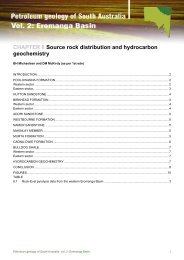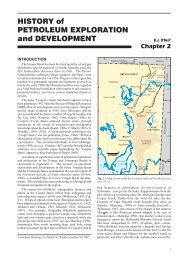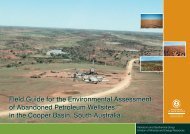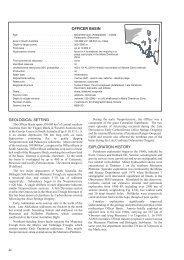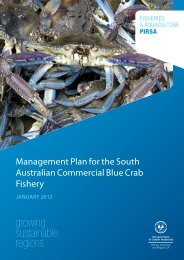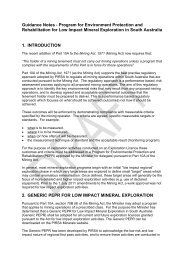Chapter 7 - MISA
Chapter 7 - MISA
Chapter 7 - MISA
You also want an ePaper? Increase the reach of your titles
YUMPU automatically turns print PDFs into web optimized ePapers that Google loves.
CHAPTER 7 Biostratigraphy<br />
R Morgan, NF Alley, AI Rowett and MR White<br />
EARLY CRETACEOUS..........................................................................................................2<br />
Introduction ............................................................................................................................2<br />
Palynology..............................................................................................................................2<br />
History of zonation .............................................................................................................2<br />
Differing inter-basin species ranges ..............................................................................2<br />
Scarcity of key species..................................................................................................2<br />
Differing species range concepts...................................................................................3<br />
Zonation framework................................................................................................................3<br />
LATE CRETACEOUS ............................................................................................................4<br />
Introduction ............................................................................................................................4<br />
Palynology..............................................................................................................................4<br />
History of zonation .............................................................................................................4<br />
Pollen and spores .........................................................................................................4<br />
Dinoflagellates...............................................................................................................5<br />
TERTIARY .............................................................................................................................5<br />
Petroleum geology of South Australia. Vol. 1: Otway Basin. 1
<strong>Chapter</strong> 7 Biostratigraphy<br />
EARLY CRETACEOUS<br />
Introduction<br />
Plant microfossils are abundant and diverse in the claystone and coal of the Casterton<br />
Formation, Crayfish Group and Eumeralla Formation, and only absent from sandstone.<br />
Terrestrial spores and pollen dominate the assemblages with high diversity in the Aptian to<br />
Albian, but reduced diversity in the Neocomian to ?Tithonian. Dispersed cuticle is also well<br />
represented throughout this interval (Rowett, 1994b).<br />
Non-marine algae can be frequent, but only Microfasta evansii appears to have time<br />
significance. Spiny acritarchs and dinoflagellates are very rare, indicating some brackish<br />
intervals. A paralic dinoflagellate assemblage, probably of Diconodinium davidii Zone age,<br />
occurs in a few wells, possibly reflecting a marine maximum. Marine influence is<br />
concentrated in the western part of the basin, and may be more widespread in deeper rifted<br />
blocks as an extension of the more persistent marine influence seen in the Duntroon Basin.<br />
Such marine horizons have high correlative value as they probably reflect isochronous<br />
maximum flooding surfaces, but they may be thin. Drill cuttings may be the best means of<br />
detecting marine fossil indicators. Other fossil groups do not yet have proven potential for<br />
correlation.<br />
Palynology<br />
History of zonation<br />
The widely used spore–pollen zonation of Helby et al. (1987) is essentially that of Dettmann<br />
(1963), based on Otway and Eromanga Basin data (Fig. 7.1). Subsequent Otway Basin<br />
studies have produced the refinements of Evans (1966) and Dettmann (1986). Problems<br />
applying the zonation are due to three factors, all of which complicate the correlation of the<br />
Neocomian to Aptian Cyclosporites hughesii Zone. These factors are (i) differences in ranges<br />
of taxa between basins, (ii) extreme scarcity of some index taxa, and (iii) different ranges<br />
being used by different authors in the Otway Basin.<br />
DIFFERING INTER-BASIN SPECIES RANGES<br />
Dettmann and Playford (1969) and Helby et al. (1987) attempted to produce zonations valid<br />
for all of eastern Australia (including the Otway and Eromanga Basins) despite some key<br />
species having different ranges between basins. Although generally successful, correlation of<br />
the base of the C. hughesii Zone of Helby et al. (1987) or its equivalent subzone of Dettmann<br />
and Playford (1969) is a problem, since the ranges of several important species are different,<br />
e.g. Dettmann (1986). As a result, the base of the C. hughesii Zone has been correlated<br />
differently by different authors. In particular, the oldest occurrences of Pilosisporites notensis<br />
and Foraminisporis asymmetricus are nearly always coincident in the Eromanga Basin, but<br />
consistently different in the Otway Basin. Morgan (1980), working in the Eromanga Basin,<br />
used oldest P. notensis to correlate the two. As a result, the C. hughesii Zone (sensu<br />
Dettmann and Playford, 1969) may extend to slightly older horizons than C. hughesii Zone<br />
(sensu Helby et al. 1987, fig. 10) This different usage has been most confusing and as a<br />
solution Morgan et al. (1995, app. 6) introduced a new zonal name (P. notensis Zone) for the<br />
Helby et al. (1987) concept.<br />
SCARCITY OF KEY SPECIES<br />
The above difficulties were largely caused by the extreme scarcity of some zonal fossils.<br />
Specifically, the base of the C. hughesii Zone was defined on the basis of the occurrence of<br />
youngest Crybelosporites stylosus, a species found to be too scarce to be reliable. Attempts<br />
to redefine this boundary on other criteria resulted in inconsistent usage as detailed above.<br />
Several other ‘zone markers’ of Dettmann and Douglas (1976) were found by Morgan et al.<br />
(1995) to be too scarce to be reliable, and other taxa with similar but more consistent ranges<br />
were substituted. Specifically, youngest Cooksonites variabilis was substituted for oldest<br />
Petroleum geology of South Australia. Vol. 1: Otway Basin. 2
<strong>Chapter</strong> 7 Biostratigraphy<br />
F. asymmetricus, oldest P. notensis substituted for youngest Murospora florida, and oldest<br />
Dictyotosporites speciosus substituted for youngest C. stylosus. These substitutions have<br />
varied the respective boundaries only slightly: up, not at all; and down, as shown in Figure<br />
7.1.<br />
Another key taxon which is very rare near its oldest occurrence is Cicatricosisporites<br />
australiensis (or other species of the genus), the species used to define the base of the<br />
Australian Cretaceous. This species is very consistent to frequent in the Phimopollenites<br />
pannosus to basal P. notensis Zones, rare but consistent in the upper Foraminisporis<br />
wonthaggiensis Zone, and extremely rare beneath. The defining criterion for the base of the<br />
C. australiensis Zone is thus useless in the Otway Basin, and the lower C. australiensis Zone<br />
cannot be distinguished from the Retitriletes watherooensis Zone. They were lumped by<br />
Morgan et al. (1995) as a ‘lower C. australiensis to R. watherooensis’ interval, which may<br />
therefore be entirely Cretaceous in age, but which might be partly Late Jurassic (Fig. 7.1).<br />
The presence of a Jurassic section in the Otway Basin is unproven; this interval is usually<br />
recorded from the Casterton Formation.<br />
F. wonthaggiensis is also consistent in the P. pannosus to upper F. wonthaggiensis Zones,<br />
very scarce or absent in the lower F. wonthaggiensis Zone (as defined by oldest<br />
D. speciosus discussed above) and absent beneath. Correlation using oldest<br />
F. wonthaggiensis can thus be risky.<br />
DIFFERING SPECIES RANGE CONCEPTS<br />
Another significant problem is different ranges reported by different authors for the same<br />
species. In particular, Dettmann (1986) reported the following oldest occurrences in<br />
descending order: F. asymmetricus, Triporoletes reticulatus, coincident<br />
P. notensis/F. wonthaggiensis, then D. speciosus. Morgan et al. (1995) see them in a<br />
different order, namely F. asymmetricus, P. notensis coincident T. reticulatus/consistent<br />
F. wonthaggiensis, then absolute F. wonthaggiensis then D. speciosus. Clearly the two<br />
ranges for P. notensis cannot be easily reconciled but may be caused by diachronism within<br />
the basin, or by sample mix-up or contamination. R Morgan (Morgan Palaeo Associates,<br />
pers. comm., 1995) believes that oldest P. notensis is synchronous in the Otway and<br />
Eromanga Basins at base Aptian, for some of the geological reasons outlined below.<br />
Zonation framework<br />
Because of these complicating factors, the best approach is to erect a zonation which works<br />
in the Otway Basin (while changing the existing framework as little as possible) and makes<br />
sense against the geological and seismic constraints. The sequence of events shown in<br />
Figure 7.1 can be constructed and general agreement reached amongst palynologists active<br />
in the basin with the possible exception of Dettmann regarding oldest P. notensis. These<br />
zones can be named as in Figure 7.1 and applied easily in the South Australian Otway Basin<br />
at least. Close liaison with industry geologists and geophysicists indicates that the<br />
P. notensis/F. wonthaggiensis Zone boundary occurs consistently at the common angular<br />
unconformity at the base of the Eumeralla Formation, and can usually be located within<br />
metres using oldest P. notensis above the unconformity, and youngest occurrences of the<br />
alga M. evansii below. These palynological criteria are vital in the identification of Katnook<br />
Sandstone. Significant blooms of M. evansii, which probably represent maximum lake<br />
development, usually occur in the upper F. wonthaggiensis Zone in the Laira Formation and<br />
can be correlated locally (Morgan, 1993). However, locally (Kalangadoo 1) they may be<br />
reworked in to sediments above the unconformity. Much or all of the underlying section can<br />
also be truncated at the unconformity.<br />
Research using quantitative dispersed cuticle and spore–pollen data has improved resolution<br />
of the Crayfish Group. The study, focusing on floristic trends and associations of common,<br />
Petroleum geology of South Australia. Vol. 1: Otway Basin. 3
<strong>Chapter</strong> 7 Biostratigraphy<br />
well-represented taxa, successfully subdivided the F. wonthaggiensis and C. australiensis<br />
Zones of Helby et al. (1987) into various palynological and dispersed cuticle zones (Rowett,<br />
1994b, c).<br />
No dinoflagellate zonation can yet be applied as marine influence is too minor and<br />
ephemeral. The late Aptian marine horizon noted above is a useful datum and more closespaced<br />
sampling of cuttings, especially in deep palaeogeographic settings, may prove a<br />
more extensive marine section.<br />
In summary, the correlative framework is fair to good. Too few core and sidewall samples<br />
have been studied from the bland assemblages of the Casterton Formation to consider them<br />
well controlled, and they could be all Cretaceous or partly Jurassic. Within the Neocomian, all<br />
zonal boundaries are based on oldest occurrences of fairly rare species and so boundaries<br />
may appear to be diachronous due to scarcity of marker species. Experience has shown that<br />
if these are absent from three or more consecutive samples then the absence is real. In the<br />
Laira Formation, local high resolution can be achieved using algal acmes. The top Crayfish<br />
Group unconformity can usually be located fairly precisely at the base of the P. notensis<br />
Zone as frequent excellent markers are available. Zones in the Eumeralla Formation interval<br />
can be confidently identified with the possible exception of the upper/lower P. notensis Zone<br />
boundary which is of lower confidence, being based on the youngest occurrence of the rare<br />
species C. variabilis.<br />
Age control in the section is poor in the Neocomian as these continental palynofloras lack<br />
associated marine fossil control. The Aptian to Albian is well calibrated due to the marine<br />
megafauna associated with these zones in the Eromanga Basin to the north.<br />
LATE CRETACEOUS<br />
Introduction<br />
Plant microfossils are abundant and diverse in claystone of the Late Cretaceous Sherbrook<br />
Group and only absent from sandstone lithologies. Terrestrial spores and pollen dominate,<br />
but are of more limited diversity in the Santonian to Cenomanian, reducing resolution.<br />
Dinoflagellates are much less frequent throughout, but are common and distinctive at certain<br />
horizons, providing useful correlations. Again, resolution is less in the early Santonian to<br />
Cenomanian. Other fossil groups are not very useful, although foraminifera have some<br />
application in the marine horizons.<br />
Palynology<br />
History of zonation<br />
POLLEN AND SPORES<br />
The spore–pollen zonation evolved in two halves. The older half (Tricolporites apoxyexinus<br />
to Appendicisporites distocarinatus Zones) was developed in the Otway Basin in response to<br />
oil company exploration (Dettmann and Playford, 1969). Palynofloras above this point were<br />
loosely grouped into a ‘Nothofagidites microflora’. The younger half of the palynological<br />
succession (Nothofagidites senectus to Tricolpites (Forcipites) longus Zones) was developed<br />
in the Gippsland Basin by Esso, and was published by Stover and Evans (1973), Stover and<br />
Partridge (1973) and Partridge (1976). These two halves were brought together by Helby et<br />
al. (1987), and provide the current framework (Fig. 7.1). The bases of the zones are mostly<br />
defined on oldest occurrences of key marker species, several of which are quite rare, near to<br />
the base of their range. They may therefore appear diachronous at times, especially in<br />
cuttings where specimens may be caved. The base of the T. apoxyexinus Zone is especially<br />
difficult, as the nominate species is always extremely rare. However, the base of a large<br />
increase in Amosopollis cruciformis is nearly coincident and may be more regionally valid.<br />
Other criteria are currently being tested.<br />
Petroleum geology of South Australia. Vol. 1: Otway Basin. 4
<strong>Chapter</strong> 7 Biostratigraphy<br />
DINOFLAGELLATES<br />
The dinoflagellate zonation also evolved in a piecemeal fashion. The Campanian to<br />
Santonian Xenikoon australis to Isabelidinium cretaceum and Cenomanian Ascodinium<br />
parvum Zones were developed by Evans (1966) in the Otway Basin. The youngest zones are<br />
certainly the most distinctive and are easily recognised. The late Maastrichtian Mannumiella<br />
druggii Zone was developed in the Gippsland Basin and published by Partridge (1976)<br />
without definition. It is easily identified in the Otway Basin although often only as a brief<br />
interval. The Conosphaeridium striatoconus and Odontochitina porifera Zones were<br />
described from New Zealand by Wilson (1984), but the oldest occurrences of the nominate<br />
species can be very rare. All these were compiled, and the last three zones added, by Helby<br />
et al. (1987, fig. 2).<br />
Several aspects of this framework require comment. Resolution is certainly best in the<br />
X. australis to I. cretaceum interval and new subzones are being tested. Below this, the<br />
O. porifera and C. striatoconus Zones frequently appear diachronous due to extreme scarcity<br />
to absence of zonal fossils. New zonal definitions in this interval are being tested, although<br />
the published definitions can be applied in more open marine sections in the Carnarvon and<br />
Perth Basins. The Palaeohystricophora infusorioides, Isabelidinium korojonense and<br />
M. druggii Zones can be reliably identified in favourable facies, but marginally marine to nonmarine<br />
facies sometimes make interpretation difficult. The Cenomanian Diconodinium<br />
multispinum Zone has not yet been identified in the Otway Basin although it occurs in the<br />
Duntroon Basin to the west. This may be due to restricted marine facies and the absence of<br />
key fossils in the basin, or may be caused by a regional mid Cretaceous hiatus.<br />
Age control for the Late Cretaceous is good, being based on planktonic foraminifera and<br />
nannofossils associated with the dinoflagellate zones in offshore Western Australia, and the<br />
Bight and Duntroon Basins.<br />
TERTIARY<br />
The Tertiary biostratigraphy is not discussed in detail. Plant microfossils are abundant and<br />
diverse in claystone of the Pebble Point – Dilwyn succession (Paleocene to Middle Eocene).<br />
Terrestrial spores and pollen are dominant and diverse, but marine dinoflagellates usually<br />
minor. Above the Dilwyn Formation, plant microfossils become less frequent and sporadic in<br />
occurrence because of the establishment of marine conditions represented by carbonates.<br />
However, palynology is still quite useful up to the Early Miocene, at least in Victoria. In<br />
contrast, foraminifera (particularly planktonic foraminifera) are not abundant in the Paleocene<br />
to Middle Eocene part of the succession but are often abundant in the younger strata.<br />
Petroleum geology of South Australia. Vol. 1: Otway Basin. 5
<strong>Chapter</strong> 7 Biostratigraphy<br />
FIGURES<br />
7.1 Late Jurassic to Late Cretaceous palynological zonal nomenclature relevant to the<br />
Otway Basin<br />
Petroleum geology of South Australia. Vol. 1: Otway Basin.
AGE IN Ma<br />
60<br />
70<br />
80<br />
90<br />
100<br />
110<br />
120<br />
130<br />
140<br />
PERIOD<br />
Pg<br />
CRETACEOUS<br />
JURAS<br />
-SIC<br />
EPOCH<br />
60.2<br />
LATE<br />
EARLY<br />
LATE<br />
NEOCOMIAN SENONIAN<br />
AGE<br />
(After Harland<br />
et al., 1982)<br />
150<br />
65<br />
73<br />
83<br />
SANTONIAN<br />
87.5<br />
CONIACIAN<br />
88.5<br />
TURONIAN<br />
91<br />
CENOMANIAN<br />
97.5<br />
113<br />
119<br />
125<br />
131<br />
138<br />
144<br />
DANIAN<br />
MAASTRICHTIAN<br />
CAMPANIAN<br />
VRACONIAN<br />
ALBIAN<br />
APTIAN<br />
BARREMIAN<br />
HAUTERIVIAN<br />
VALANGINIAN<br />
BERRIASIAN<br />
TITHONIAN<br />
SUPERZONE<br />
F. CYLINDRICA MUDERONGIA HETEROSPHAERIDIUM ISABELIDINIUM<br />
Helby et al.,<br />
1987<br />
DINOFLAGELLATE<br />
ZONES<br />
T. evitii<br />
M. druggii<br />
I. korojonense<br />
X. australis<br />
N. aceras<br />
I. cretaceum<br />
O. porifera<br />
C. striatoconus<br />
P. infusorioides<br />
D. multispinum<br />
X. asperatus<br />
P. ludbrookiae<br />
C. denticulata<br />
M. tetracantha<br />
D. davidii<br />
O. operculata<br />
A. cinctum<br />
M. australis<br />
SPORE-POLLEN<br />
ZONES<br />
Lygistepollenites<br />
balmei<br />
Forcipites<br />
(al.Tricolporites)<br />
longus<br />
Tubulifloridites<br />
(al.Tricolporites)<br />
lilliei<br />
Nothofagidites<br />
senectus<br />
Tricolporites<br />
apoxyexinus<br />
Phyllocladidites<br />
mawsonii<br />
Appendicisporites<br />
distocarinatus<br />
Phimopollenites<br />
pannosus<br />
Coptospora<br />
paradoxa<br />
Crybelosporites<br />
striatus<br />
Cyclosporites<br />
hughesii<br />
Foraminisporis<br />
M. testudinaria<br />
wonthaggiensis<br />
P. burgeri<br />
S. tabulata<br />
S. areolata<br />
E. torynum<br />
B. reticulatum<br />
B. lobispinosum Cicatricosisporites<br />
C. delicata australiensis<br />
K. wisemaniae<br />
P. iehiense<br />
D. jurassicum Retitriletes<br />
O. montgomeryi watherooensis<br />
C. perforans<br />
Dettman and<br />
Playford, 1969<br />
Cyclosporites<br />
hughesii<br />
Fig. 6.1 Late Jurassic - Late Cretaceous palynological zonal nomenclature<br />
Dettman, 1986 Morgan, 1980 Morgan, 1985<br />
Otway Basin<br />
Review<br />
Morgan, 1989<br />
(Katnook 1 & 2)<br />
Morgan, 1993 Burger, 1980 Evans, 1966,<br />
1971<br />
CSR/APG<br />
Consultants<br />
pre -1985<br />
terminology<br />
APG Consultants<br />
Eromanga/Surat terminology<br />
A. distocarinatus A. distocarinatus A. distocarinatus A. distocarinatus A. distocarinatus A. distocarinatus A. distocarinatus A. distocarinatus APK7<br />
A. distocarinatus<br />
P. pannosus P. pannosus P. pannosus P. pannosus P. pannosus P. pannosus P. pannosus P. pannosus<br />
APK6<br />
P. pannosus<br />
C. paradoxa<br />
Upper<br />
C. paradoxa<br />
Lower<br />
C. paradoxa<br />
Upper<br />
Lower<br />
Upper<br />
Lower<br />
Upper<br />
C. paradoxa<br />
Lower<br />
C. paradoxa<br />
C. paradoxa<br />
K2b<br />
K2a<br />
C. paradoxa<br />
APK5<br />
APK5.2<br />
APK5.1<br />
Upper<br />
Lower<br />
Dictyotosporites speciosus<br />
Dictyotosporites speciosus<br />
C. paradoxa<br />
Upper Upper Upper UpperC.<br />
hughesii<br />
Middle<br />
Lower<br />
Middle<br />
Lower<br />
C. paradoxa<br />
C. striatus C. striatus C. striatus C. striatus C. striatus C. striatus C. striatus K1d<br />
C. striatus APK4<br />
C. striatus<br />
C. hughesii<br />
Crybelosporites Crybelosporites<br />
stylosus stylosus<br />
D. speciosus<br />
C. stylosus<br />
C. hughesii<br />
F.<br />
wonthaggiensis<br />
C. australiensis<br />
C. hughesii<br />
C. stylosus<br />
C. hughesii<br />
Lower<br />
Lower<br />
C. hughesii<br />
Upper<br />
F. wonthaggiensis<br />
F. wonthaggiensis<br />
Lower<br />
F. wonthaggiensis<br />
Osmundacidites dubius<br />
Foraminisporis<br />
asymmetricus<br />
Murospora florida<br />
F.<br />
wonthaggiensis<br />
K1b-c<br />
K1a<br />
C. hughesii<br />
F. wonthaggiensis<br />
C. paradoxa<br />
This<br />
Volume<br />
APK1.2.2<br />
Upper C. australiensis<br />
APK1.2<br />
C. australiensis C. australiensis APK1.2.1<br />
C. australiensis APK1<br />
Upper C. australiensis<br />
Lower<br />
APK1.1<br />
Lower<br />
C. australiensis/<br />
APJ6.2 APJ6.2.2 C. australiensis/<br />
R. watherooensis R. watherooensis<br />
J6<br />
APJ6.2.1<br />
UJ5-6C<br />
APJ6<br />
R. watherooensis<br />
APJ6.1<br />
APK3<br />
APK2<br />
APK3.2<br />
APK3.1<br />
APK2.2<br />
APK2.1<br />
Pilosisporites<br />
notensis<br />
F. wonthaggiensis<br />
Upper<br />
Lower<br />
Upper<br />
Lower<br />
Key spore/pollen Key micro plankton<br />
events* events<br />
First appearance Last appearance<br />
Quadraplanus brossus<br />
Grapnelispora evansii<br />
Forcipites (al. Tricolporites) longus<br />
Grapnelispora evansii<br />
Tubulifloridites (al. Tricolporites) lilliei<br />
Nothofagidites senectus<br />
Tricolporites apoxyexinus<br />
Ornamentifera sentosa<br />
Phyllocladidites mawsonii<br />
Proteacidites spp.<br />
Coptospora paradoxa<br />
Crybelosporites of C. brenneri<br />
Phimopollenites pannosus<br />
Pilosisporites grandis<br />
Coptospora paradoxa<br />
Crybelosporites striatus<br />
Cooksonites variabilis<br />
Pilosisporites parvispinosus<br />
Foraminsporis asymmetricus<br />
Pilosisporites notensis<br />
Triporoletes reticulatus<br />
Foraminisporis wonthaggiensis<br />
Dictyotosporites speciosus<br />
Cyclosporites hughesii<br />
Cicatricosporites spp.<br />
Foraminisporis dailyi<br />
Ceratosporites equalis<br />
Retitriletes watherooensis<br />
Cribroperidinium<br />
edwardsii<br />
(frequent)<br />
Aptian dinoflagellate<br />
assemblage<br />
M. evansii<br />
M. evansii<br />
(consistent to frequent)<br />
M. evansii<br />
* Different ranges may occur in the western and northern part of the continent<br />
95-240 MESA










